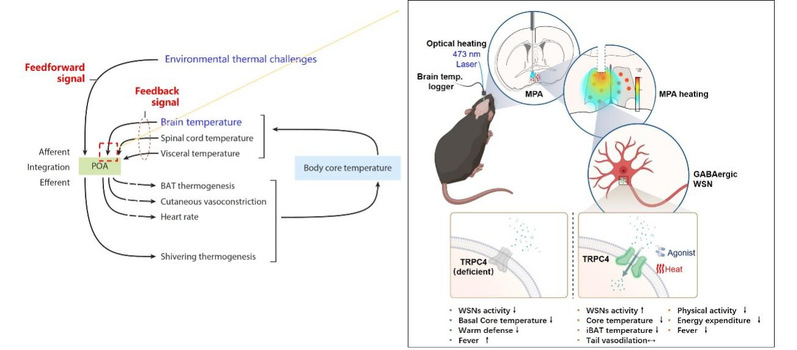Recently, Shen Wei's research group from the School of Life Science and Technology at ShanghaiTech University published an online paper titled “Hypothalamic warm-sensitive neurons require TRPC4 channel for detecting internal warmth and regulating body temperature in mice” in Neuron. The research found that TRPC4 is a key molecule for the brain to detect internal temperature and suggested that it is a novel molecular target for regulating body temperature.
Keeping the core body temperature constant is essential for the survival of mammals. The thermoregulatory center-the preoptic area-uses feedforward and feedback mechanisms to sense temperature signals and initiate thermoregulatory responses, keeping body temperature constant. Previous studies have elucidated feedforward thermoregulatory pathways in response to environmental temperature changes, but the feedback thermoregulatory mechanisms activated by internal body temperature changes are not fully understood.
The research team used the thermal effect of lasers to create a brain temperature control device suitable for mouse models, which can accurately change and measure the internal temperature of the brain when the mice are free to move. Experiments have confirmed the functions of internal warm-sensitive neurons in the hypothalamus of mice, which can regulate core body temperature in a feedback manner.
Via a pilot genetic screen, the research team then discovered that silencing the TRPC4 ion channel in mice significantly reduced hypothermia induced by light-induced heating of the POA. Further investigations confirmed that TRPC4 plays a critical role in warm sensing in GABAergic WSNs, affecting not only basal temperature regulation but also warm defense and fever responses. Additionally, TRPC4 antagonists and agonists were found to bidirectionally regulate Tcore. These findings suggest that TRPC4-expressing GABAergic WSNs serve as a novel cellular sensor for preventing Tcore from exceeding set-point temperatures and that TRPC4 may represent a potential therapeutic target for clinical hypothermia therapy and thermoregulatory diseases, such as heat shock and fever.

Figure: Graphical summary of this research.
Shen Wei, a tenured associate professor at the School of Life Science and Technology & Shanghai Clinical Research and Trial Center & Shanghai Institute for Advanced Immunochemical Studies of ShanghaiTech University, Yang Wen, an assistant researcher at the School of Life Science and Technology & Shanghai Clinical Research and Trial Center & Shanghai Institute for Advanced Immunochemical Studies of ShanghaiTech University, and Zhang Jie, a professor at the Thermoregulation and Inflammation Laboratory of Chengdu Medical College, are co-corresponding authors of this study. Zhou Qian and Fu Xin, the 2017 doctoral students in Shen Wei's research group, and Xu Jianhui, an assistant researcher at Thermoregulation and Inflammation Laboratory of Chengdu Medical College, are the co-first authors of this article. ShanghaiTech University (School of Life Science and Technology & Shanghai Clinical Research and Trial Center & Shanghai Institute for Advanced Immunochemical Studies) is the first completion unit.
Reference: https://doi.org/10.1016/j.neuron.2022.11.008


